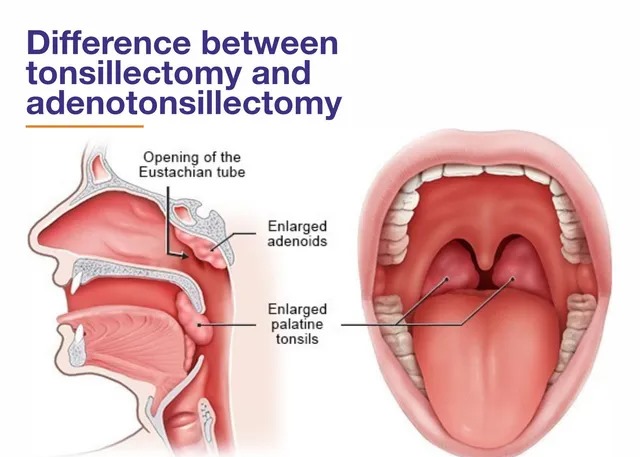Tonsils & Adenoids

TONSILS AND ADENOIDS
What are Tonsils and Adenoids?
Tonsils are soft masses rich in lymphatic tissue located on both sides of the back of the throat. Adenoids are soft masses rich in lymphatic tissue located behind the nose. This is also the region where the eustachian tubes from the ear open in the nose. Both adenoids and tonsils help your body fight infection by producing antibodies to combat bacteria that enter through the mouth and nose during childhood.
Diseases related to Tonsils
Most common conditions in tonsils:
- Tonsillitis: Recurring infections either viral or bacterial can result in acute or chronic tonsillitis. Symptoms include fever, persistent sore throat, redness in the tonsillar area, yellow discharge or spots on the tonsils, and tender lymph nodes on both sides of the neck. When it additionally involves the back of the throat or pharynx, it is called pharyngotonsillitis.
- Tonsil stones or Tonsilloliths: A harmless condition in which small hardened lumps are formed within the tonsils. Bacteria, food debris, dead cells, and mucus get trapped in spaces over the tonsils and appear as whitish particles in the tonsils. They are benign but result in a constant foreign body sensation in the throat.
- Sleep disorder: Enlarged tonsils along with enlarged adenoids can aggravate snoring and may contribute significantly to the alarming condition called sleep apnea, which involves a decline in blood oxygen levels with an occasional stoppage of breathing during sleep.
If you notice such symptoms in your child or experience similar problems, you must get yourself evaluated by an ENT specialist.
Diseases related to Adenoids
- Runny nose: Recurrent infection in the adenoid tissue located at the back of the nose can result in persistent running nose, throat irritation, and persistent cough.
- Worsens Allergies: Enlarged adenoids can aggravate symptoms of childhood asthma and allergic rhinitis.
- Ear infection: Due to enlarged adenoids, the ears can repeatedly get infected, resulting in severe ear pain with fever. This happens due to infections extending from the nose to the ears via the eustachian tubes. This also tends to persist as glue ears, which can result in decreased hearing.
- Sleep disorder: Enlarged adenoids along with enlarged tonsils can aggravate snoring and may contribute significantly to sleep apnea, which involves a decline in blood oxygen levels with an occasional stoppage of breathing during sleep.
How are Tonsils and Adenoids Treated?
When and only if the adenoids and tonsils are causing problems, they have to be treated initially with decongestants, nasal sprays, and if required, antibiotics. However, in some cases where there is no improvement with medicines, the adenoids have to be assessed with either nasal endoscopy or X-rays to evaluate the need for any surgical intervention.
Surgery of Tonsils and Adenoids
Removal of adenoids and tonsils is a very safe procedure done either as a daycare procedure or with 24 hours of admission. Currently, the technique of removal is by coblation.
Coblation Adeno-Tonsillectomy
Coblation Adeno-Tonsillectomy is the world's most advanced technique for bloodless tonsillectomy and adenoidectomy.
What is Coblation Adeno-Tonsillectomy?
Unlike traditional procedures, Coblation is an advanced technology that combines gentle radiofrequency energy with natural saline to quickly and safely remove tonsils and adenoids. Because traditional procedures use high levels of heat to remove the tonsils, damage to surrounding healthy tissue is common. Coblation does not remove the tonsils by heating or burning, leaving the healthy tissue surrounding the tonsils intact.
The innovative approach of Coblation results in minimal pain and rapid recovery for patients. Coblation has been used in nearly three million procedures by surgeons in ear, nose, and throat (ENT) and other areas of medical specialty.
Why Is Coblation Adeno-Tonsillectomy A Better Choice?
Patients report a better overall experience with Coblation Adeno-Tonsillectomy after surgery when compared to traditional procedures. Studies show that patient calls and visits to the doctor due to complications after surgery are significantly less with Coblation Adeno-Tonsillectomy. It is the gentle alternative offering a rapid recovery and minimal pain, with most patients resuming a normal diet and activities within just a few days.

